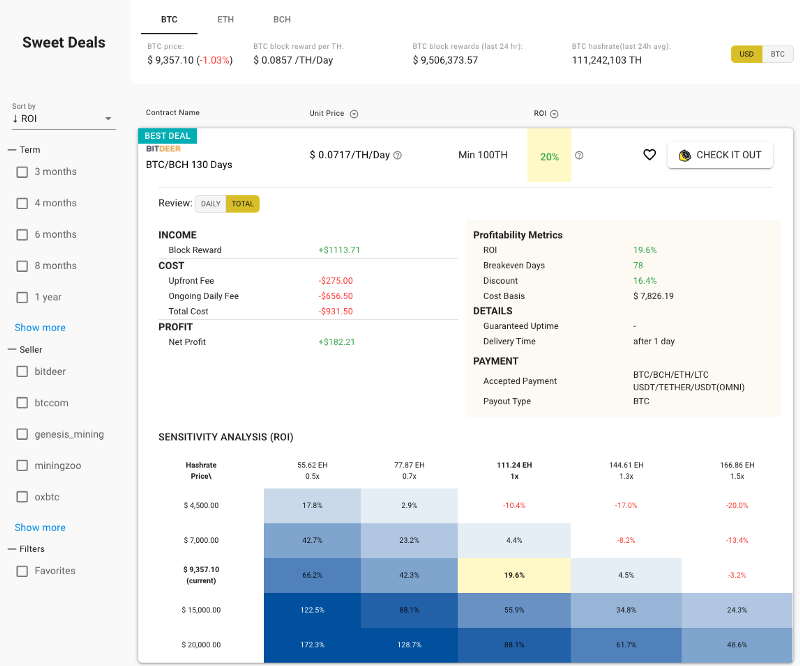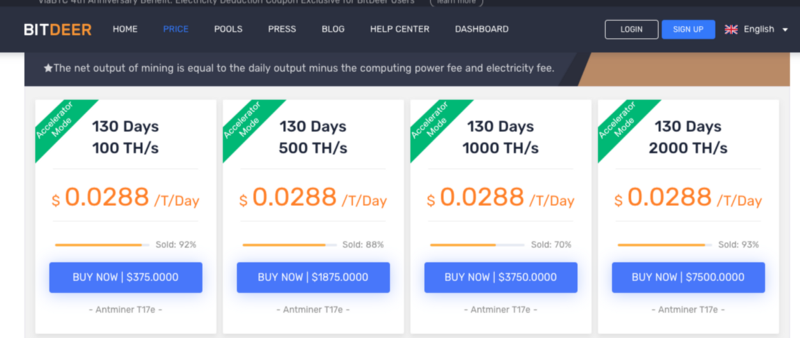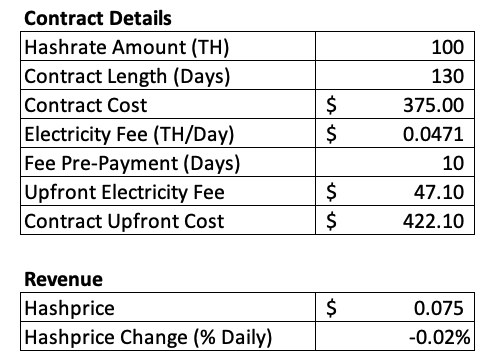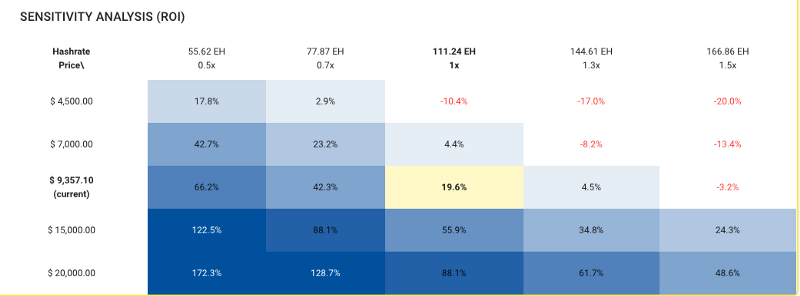
What Is Bitcoin Cloud Mining? Is Bitcoin Cloud Mining Profitable?
Here are some key questions to ask a potential hosting provider to ensure what is being quoted as all-in or managed services truly are managed. You can use this checklist to help select a hosting provider.
One of the most searched questions on cloud mining is around profitability. All of the top results are written by news sites who have probably never mined before or even bought a cloud mining contract. We thought it was about time there was a comprehensive guide on how to analyze a cloud mining contract and determine if it's a good investment.
Disclaimer: Not Trading or Investment Advice
In this analysis we went to Honey Lemon, a cloud mining aggregator to find the “top” cloud mining contract. The 130-day Bitdeer contract shown below is apparently one of the best cloud mining contracts out there so let’s put it to the test and see if it makes sense to buy it.

Cloud Mining
Cloud mining is a term used to describe companies that offer contracts of compute power (“hashrate”) to mine Bitcoin and other PoW coins. Instead of investing in mining hardware directly, buyers can purchase a cloud mining contract and rent the hashrate produced from a machine. The buyer pays some form of currency (usually Bitcoin) in return for a set amount of hashrate (i.e. 100 TH/s) for a set time period (i.e. 130 days). The buyer pays a fixed rate at the start with the hopes that their contract returns more than they originally put in, or some IRR above their cost of capital.
We also put together a full guide on cloud mining in general here.
Analysis
We break the investment decision down into a few different parts that build into a financial analysis.
- Determining if a Platform is Legit
- Understanding the Cost
- Forecasting Revenue
- Calculating Expected Profitability (IRR)
- Building a Sensitivity Analysis
Determining if a Platform is Legit
Over the past 7 years there have been dozens of “cloud mining” platforms that turned out to be a scam. Most often these platforms did not actually have the hashrate that they promised to deliver to buyers. So buyers ended up putting money in and getting nothing in return. A few of the more public ones were HashOcean, Bitcoin Cloud Services, GAW, BitClub.
This is an area I would be very cautious about. It is crucial to make sure that the company you are purchasing a contract from will actually uphold that agreement and deliver you the specified hashrate. Some on the more well known cloud mining platforms are Genesis Mining, Bitdeer, via.BTC and Bitcoin.com.
For this example the contract is from Bitdeer, a subsidiary of mining giant Bitmain. Although there may be questions on the ethicality of the platform, generally people think Bitdeer does deliver the hashrate it was promised. Because the cloud mining company is connected with a well known company, the risk is much lower than a new company with no historic ties. However, there is always a counter-party risk that your hashrate doesn’t get delivered.
Understanding the Cost
On the product page you can see Bitdeer’s 130-day BTC/BCH contract for sale in different hashrate amounts. Let’s go with the 100TH/s contract, which has a cost of \$375 USD. This amount must be paid at the start of the contract.

The other main fee is an ongoing electricity fee of \$0.0471/TH/Day. At minimum you must pre-pay 10 days. Buyers also have the option to pre-pay up to 60 days. Buyers don’t get a discount by pre-paying so we will set it to 10 days. Remember a dollar today is worth more than a dollar tomorrow.

That means that the last 120 days of the contract (Full term — deposit) will cost $4.71 a day for the 100TH. All together the contract will cost $422.1 USD upfront +\$565.2 during the contract.
Forecasting Revenue
This is one of the hardest parts of the analysis because it requires a lot of your own estimation.
Bitdeer restricts what buyers can do with their hashrate. They are limited to pointing it at one of the Bitmain pools. It is unclear if these pools mine Bitcoin and/or Bitcoin Cash. We will assume that they are mining Bitcoin for now.

As history has shown the value of hashrate experiences a consistent decline in value over time. As more hashrate gets added to the network the existing hashrate loses some value. So it is extremely important that you factor this in when projecting revenue.

Currently the value of hashrate is equal to around \$0.075 TH/s per day. Make sure you also check to see the next difficult adjustment and if there is about to be a large change in the value of hashrate.
Since Jan-2016, the value of hashrate has decreased on average -0.06% per day. For this analysis we will be a bit more aggressive than historical decline given the slowing in chip technology. We will assume a daily decline of -0.02% for the life of the contract. So over the course of the 130 day contract we will work down from $0.075 TH/s/Day to $0.074 TH/s/Day. This analysis can be much more detailed and would urge you to spend more time on it if making a large investment decision.
Calculating Expected Profitability (IRR)
Building a Model
So now that we have both our costs and expected revenue over the 130-day contract we can go ahead and build that into a Excel model.
I would start by putting in the contract details and assumptions into the top left hand corner of the sheet such as the below.

After you have all these parameters you can build a cash flow statement. Given the contract is only 130 days I built this out per day but you could also do it by difficulty adjustment period, month etc.
The revenue will simply be the hashprice ($/TH/Day) multiplied by the number of TH in the contract. The intial cost will be the contract price + the first 10 days of pre-payment. Then in Day 11 the cost will be the electricity fee ($/TH/Day) multiplied by the number of TH in the contract.

Once you have these cash flows you can do a number of profitability calculations including payback period, ROI, IRR & NPV.
Using IRR to Drive Investment Decisions
Internal rate of return (IRR) is a discount rate that makes the net present value of all cash flows from a particular investment equal to zero.
IRR is a powerful tool for capital investment decisions such as buying a cloud mining contract. It is a great tool for investments with uncertain and uneven distributions throughout the lifetime of the investment.
Most importantly IRR factors in the time value of money (opportunity cost). There are many investment opportunities both inside mining and outside. Instead of buying a cloud mining contract you could buy a rig and host in a colocation, buy Bitcoin, buy equity or even sit in USD. Each investment has different risk profiles so will naturally have different return expectations. The riskier the investment the higher the expected return needs to be. This is known as the required rate of return (RRR).
Determining a RRR for Cloud Mining
There is no single RRR for all people buying cloud mining contracts. It must be done at the individual level depending on your unique position.
For me I really look at the risk profile of cloud mining. I think its incredibly risky because it is all hashrate price risk. I would rather take operating risk by running my own mining operations. In this contract I am at the mercy of the value of hashrate. Hashrate is extremely volatile. In fact, it is about 3 times more volatile than Bitcoin.
With this in consideration I would put my personal RRR at around 25%.
Calculating IRR & Making a Decision
Heading back to our excel model the next step is to calculate the IRR of the investment. To do this simply use the formula = IRR(cash flows) and just drag in the cash flows over the 130 days.
This gives us an IRR of -29%.
Given this IRR is not larger than my RRR I would decide not to purchase this cloud mining contract. The expected return is not higher than what I would expect given the risk profile.
Building a Sensitivity Analysis
You may have noticed the fancy table on the Honey Lemon contract page. This table is called a sensitivity analysis. It allows you to flex some key assumptions like the value of hashrate. It is useful in building downside and upside cases to the investment.

You can build this type of table in excel by going to the Data tab, What-if-Analysis and then adding a Data Table.
Conclusion
While cloud mining contracts have a great UX given the low barrier to entry, it is crucial that you evaluate the contract ahead of purchasing it. Today, most contracts are unfairly priced and buyers often end up losing money.
Hashrate Index Newsletter
Join the newsletter to receive the latest updates in your inbox.






